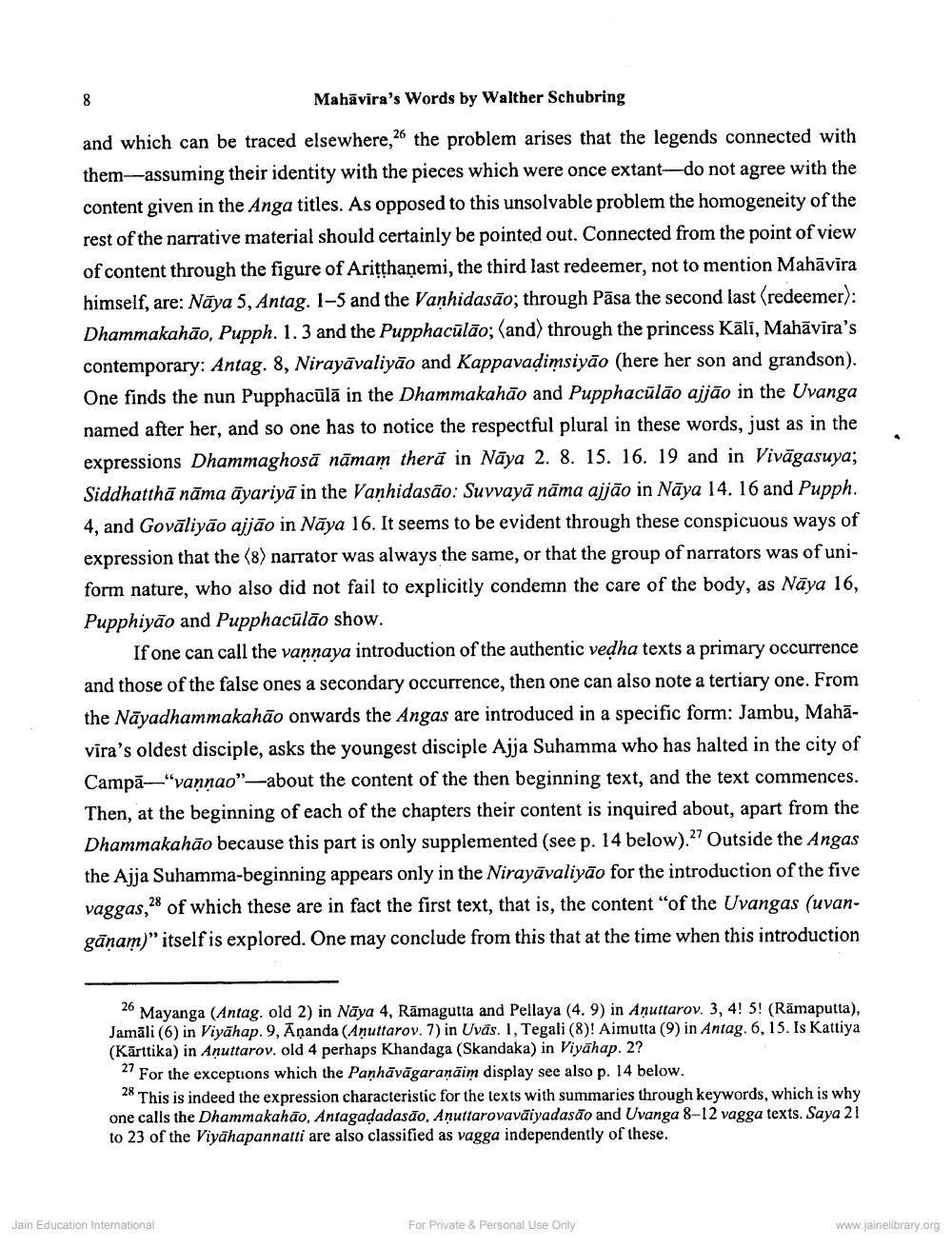________________
Mahāvira's Words by Walther Schubring
and which can be traced elsewhere,26 the problem arises that the legends connected with them-assuming their identity with the pieces which were once extant—do not agree with the content given in the Anga titles. As opposed to this unsolvable problem the homogeneity of the rest of the narrative material should certainly be pointed out. Connected from the point of view of content through the figure of Aritthaņemi, the third last redeemer, not to mention Mahāvīra himself, are: Nāya 5, Antag. 1-5 and the Vanhidasão; through Pāsa the second last (redeemer): Dhammakahāo, Pupph. 1. 3 and the Pupphacūlāo; (and) through the princess Kāli, Mahāvira's contemporary: Antag. 8, Nirayāvaliyāo and Kappavadimsiyāo (here her son and grandson). One finds the nun Pupphacūlā in the Dhammakahāo and Pupphacūlāo ajjāo in the Uvanga named after her, and so one has to notice the respectful plural in these words, just as in the expressions Dhammaghosā nāmam theră in Nāya 2. 8. 15. 16. 19 and in Vivāgasuya; Siddhatthā nāma āyariyā in the Vanhidasão: Suvvayā nāma ajjāo in Nāya 14. 16 and Pupph. 4, and Govāliyão ajjāo in Nāya 16. It seems to be evident through these conspicuous ways of expression that the (8) narrator was always the same, or that the group of narrators was of uniform nature, who also did not fail to explicitly condemn the care of the body, as Nāya 16, Pupphiyão and Pupphacūlāo show.
If one can call the vannaya introduction of the authentic vedha texts a primary occurrence and those of the false ones a secondary occurrence, then one can also note a tertiary one. From the Nāyadhammakahāo onwards the Angas are introduced in a specific form: Jambu, Mahāvira's oldest disciple, asks the youngest disciple Ajja Suhamma who has halted in the city of Campā—"vannao"-about the content of the then beginning text, and the text commences. Then, at the beginning of each of the chapters their content is inquired about, apart from the Dhammakahāo because this part is only supplemented (see p. 14 below).?' Outside the Angas the Ajja Suhamma-beginning appears only in the Nirayāvaliyāo for the introduction of the five vaggas,28 of which these are in fact the first text, that is, the content "of the Uvangas (uvangānam)" itself is explored. One may conclude from this that at the time when this introduction
26 Mayanga (Antag. old 2) in Nāya 4, Rāmagutta and Pellaya (4.9) in Anuttarov. 3, 4! 5! (Rāmaputta), Jamāli (6) in Viyāhap. 9, Ananda (Anuttarov. 7) in Uvas. 1, Tegali (8)! Aimutta (9) in Antag. 6, 15. Is Kattiya (Kārttika) in Anuttarov. old 4 perhaps Khandaga (Skandaka) in Viyāhap. 2? - For the exceptions which the Panhāvāgaraņāim display see also p. 14 below.
28 This is indeed the expression characteristic for the texts with summaries through keywords, which is why one calls the Dhammakahão, Antagadadasão, Anuttarovaväiyadasāo and Uvanga 8-12 vagga texts. Saya 21 to 23 of the Viyahapannatti are also classified as vagga independently of these.
Jain Education International
For Private & Personal Use Only
www.jainelibrary.org




